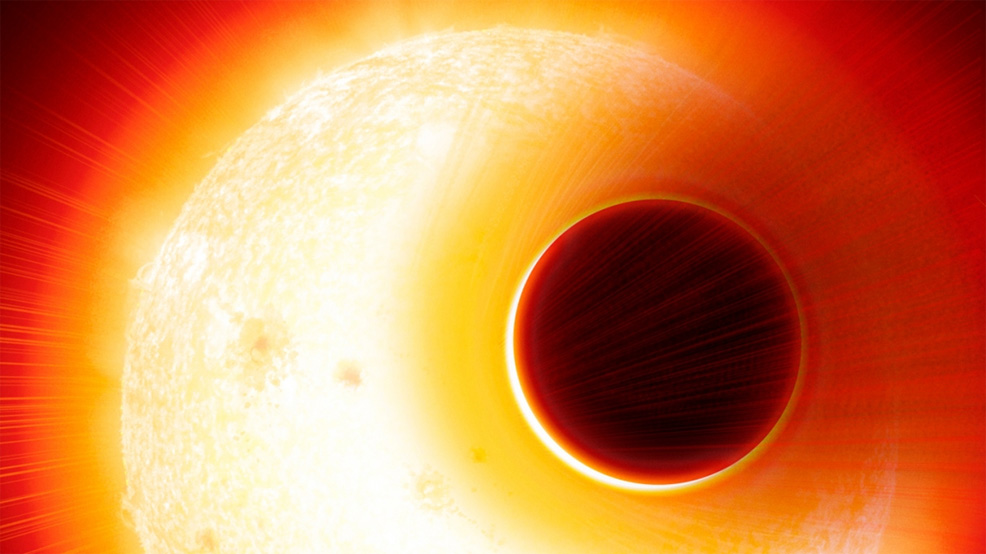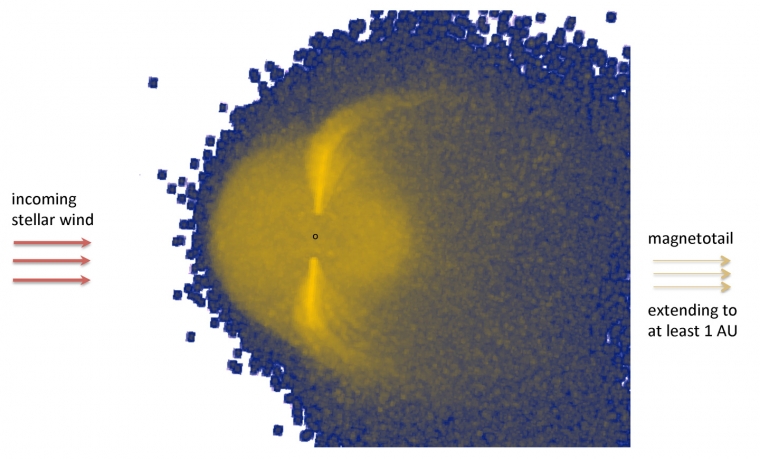
29th December 2021 First signature of a magnetosphere around an exoplanet The first known magnetic field around an exoplanet has been detected, surrounding the hot Neptune HAT-P-11b. The method used in this finding could help to determine which planets are most suitable for life.
Using data from the Hubble Space Telescope, an international team of astronomers has confirmed the signature of a magnetic field around a planet outside our Solar System. The finding, described in the journal Nature Astronomy, marks the first time such a feature has been seen on an exoplanet. A magnetic field best explains the observations of an extended region of charged carbon particles that surround the planet and stream away from it in a long tail. Magnetic fields play a crucial role in protecting planetary atmospheres, so the ability to detect the magnetic fields of exoplanets is a significant step toward better understanding what these alien worlds may look like. The team used Hubble to view the exoplanet HAT-P-11b – a Neptune-sized planet 123 light-years from Earth – as it passed directly across the face of its host star six times in what is known as a "transit." These observations occurred in the ultraviolet (UV) part of the electromagnetic spectrum, which is just beyond what the human eye can see. Carbon ions – charged particles that interact with magnetic fields – were detected around the planet in what is known as a magnetosphere. This is a region surrounding a celestial object (such as Earth, shown below) that is formed by the object's interaction with the solar wind emitted by its host star.
Earth's magnetosphere.
"This is the first time the signature of an exoplanet's magnetic field has been directly detected on a planet outside our Solar System," said Gilda Ballester, PhD, research professor at the University of Arizona Lunar and Planetary Laboratory and one of the paper's co-authors. "A strong magnetic field on a planet like Earth can protect its atmosphere and surface from direct bombardment of the energetic particles that make up the solar wind. These processes heavily affect the evolution of life on a planet like Earth, because the magnetic field shelters organisms from these energetic particles." The discovery of HAT-P-11b's magnetosphere is therefore a significant step forward in terms of understanding the habitability of an exoplanet. Not all planets and moons in our Solar System have their own magnetic fields, and the connection between magnetic fields and a planet's habitability still needs more study, according to the researchers. "HAT-P-11 b has proven to be a very exciting target, because Hubble's UV transit observations have revealed a magnetosphere, seen as both an extended ion component around the planet and long tail of escaping ions," said Ballester, adding that this general method could be used to detect magnetospheres on a variety of exoplanets and to assess their role in potential habitability. Not only did her team observe the carbon ions in a region surrounding the exoplanet, but also extending in a long tail that streamed away at average speeds of 100,000 mph. The tail reached into space for at least 1 astronomical unit, the distance between Earth and Sun. Researchers led by Lotfi Ben-Jaffel, from the Institute of Astrophysics in Paris, then used 3D computer simulations to model interactions between the planet's uppermost atmospheric regions and magnetic field with the incoming solar wind. "Just like the Earth's magnetic field and its immediate space environment interact with the impinging solar wind, there are interactions between HAT-P-11b's magnetic field and its immediate space environment with the solar wind from its host star, and those are very complex," Ballester explained. The metallicity of HAT-P-11b's atmosphere – the portion of chemical elements heavier than hydrogen and helium – is lower than expected, according to Ballester and her team. In our own Solar System, the icy gas planets of Neptune and Uranus are metal-rich but have weak magnetic fields, while the larger gas giants, Jupiter and Saturn, have low metallicity and strong magnetic fields. HAT-P-11b's low atmospheric metallicity challenges current models of exoplanet formation, according to the study authors. "Although HAT-P-11b's mass is only 8% of that of Jupiter, we think the exoplanet more resembles a mini-Jupiter than a Neptune," Ballester said. "The atmospheric composition we see on HAT-P-11b suggests that further work needs to be done to refine current theories of how certain exoplanets form in general."
Comments »
If you enjoyed this article, please consider sharing it:
|








